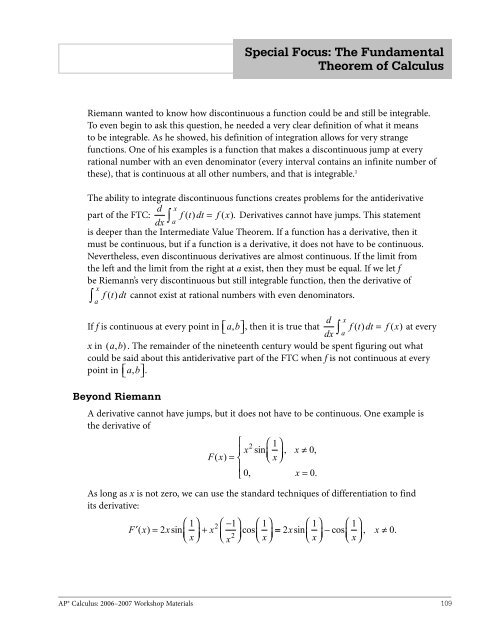AP Calculus
Calculus_SF_Theorem
Calculus_SF_Theorem
Create successful ePaper yourself
Turn your PDF publications into a flip-book with our unique Google optimized e-Paper software.
Special Focus: The Fundamental<br />
Theorem of <strong>Calculus</strong><br />
Riemann wanted to know how discontinuous a function could be and still be integrable.<br />
To even begin to ask this question, he needed a very clear definition of what it means<br />
to be integrable. As he showed, his definition of integration allows for very strange<br />
functions. One of his examples is a function that makes a discontinuous jump at every<br />
rational number with an even denominator (every interval contains an infinite number of<br />
these), that is continuous at all other numbers, and that is integrable. 1<br />
The ability to integrate discontinuous functions creates problems for the antiderivative<br />
d x<br />
part of the FTC: f t dt f x<br />
dx<br />
∫ ( ) = ( ). Derivatives cannot have jumps. This statement<br />
a<br />
is deeper than the Intermediate Value Theorem. If a function has a derivative, then it<br />
must be continuous, but if a function is a derivative, it does not have to be continuous.<br />
Nevertheless, even discontinuous derivatives are almost continuous. If the limit from<br />
the left and the limit from the right at a exist, then they must be equal. If we let f<br />
be Riemann’s very discontinuous but still integrable function, then the derivative of<br />
x<br />
∫ f ( t)<br />
dt cannot exist at rational numbers with even denominators.<br />
a<br />
d x<br />
If f is continuous at every point in ⎡⎣ a,<br />
b⎤ ⎦ , then it is true that f t dt f x<br />
dx<br />
∫ ( ) = ( ) at every<br />
a<br />
x in ( a, b ) . The remainder of the nineteenth century would be spent figuring out what<br />
could be said about this antiderivative part of the FTC when f is not continuous at every<br />
point in ⎡⎣ a,<br />
b⎤ ⎦ .<br />
Beyond Riemann<br />
A derivative cannot have jumps, but it does not have to be continuous. One example is<br />
the derivative of<br />
⎧<br />
2 ⎛ 1⎞<br />
⎪ x sin , x ,<br />
F( x)<br />
= ⎝<br />
⎜ x ⎠<br />
⎟ ≠ 0<br />
⎨<br />
⎪<br />
⎩ 0, x = 0.<br />
As long as x is not zero, we can use the standard techniques of differentiation to find<br />
its derivative:<br />
⎛ 1⎞<br />
′ =<br />
⎝<br />
⎜<br />
⎠<br />
⎟ + 2 ⎛ −1⎞<br />
⎛ 1⎞<br />
⎛ 1⎞<br />
F ( x) 2xsin x<br />
x ⎝<br />
⎜<br />
⎠<br />
⎟ cos<br />
2 ⎝<br />
⎜<br />
⎠<br />
⎟ =<br />
x x ⎝<br />
⎜<br />
⎠<br />
⎟ − ⎛ 1⎞<br />
2xsin cos<br />
⎝<br />
⎜<br />
⎠<br />
⎟ , x ≠ 0.<br />
x x<br />
<strong>AP</strong>® <strong>Calculus</strong>: 2006–2007 Workshop Materials 109


